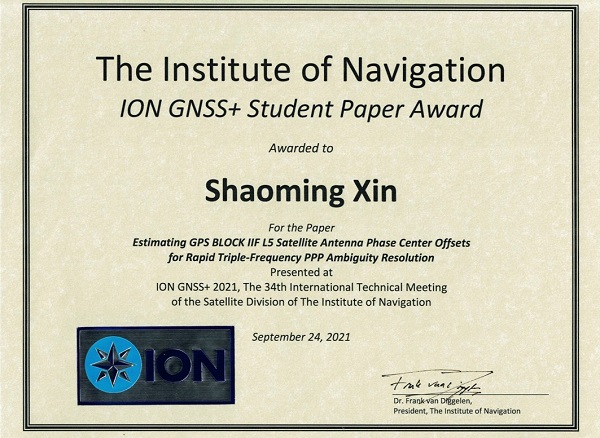课题组辛绍铭、郭将、曾燃的论文“Estimating GPS Block IIF L5 Satellite Antenna Phase Center Offsets for Rapid Triple-frequency PPP Ambiguity Resolution”获得了美国导航学会ION GNSS+ 2021优秀学生论文奖。本研究由耿江辉教授指导。在这项研究中,他们运用了一种非差非组合的三频GNSS模型来估计GPS L5信号卫星天线的相位偏差PCOs并对其进行评估。根据论文中的定位结果,对L5观测值采用新估计的GPS L5卫星天线PCO改正,相比常见的采用L1/L2 PCO 改正,可以使三频PPP-WAR和PPP-AR的收敛过程得到进一步的加快。
ION GNSS+ 年会由美国导航学会组织,是国际全球卫星导航系统及定位、导航和授时领域内最富盛名、历史最悠久的学术会议。今年全球仅有4人入选优秀学生论文奖。更多关于本研究和ION GNSS+2021会议的信息见下方链接:https://www.ion.org/gnss/abstracts.cfm?paperID=10310
以下是获奖论文证书及摘要:

Estimating GPS Block IIF L5 Satellite Antenna Phase Center Offsets for Rapid Triple-frequency PPP Ambiguity Resolution
Shaoming Xin, Jiang Guo and Ran Zeng, GNSS Research Center, Wuhan University, China
ABSTRACT
The GPS L5 antenna phase center offsets (PCOs) for the BLOCK IIF satellites have been missing over the past decade, while the Galileo and BeiDou satellites’ multi-frequency PCOs have been officially released since the year of 2017. The underlying risks of duplicating the L1/L2 satellite antenna PCOs for the L5 signals, as usually conducted in most literatures for multi-frequency GPS precise point positioning (PPP), are underestimated or even unrealized by the GNSS community. However, recent studies have shown that incorrect third-frequency PCOs can significantly deteriorate the efficiency of multi-frequency PPP ambiguity resolution (PPP-AR). Since traditional methods can only address ionosphere-free PCO estimation, we develop an approach to compute the L5 PCOs for the BLOCK IIF satellites using uncombined triple-frequency GPS observations with a second satellite clock estimated on L5 to mitigate time-variable inter-frequency satellite clock biases. One year (2019) of GPS data from about 135 globally distributed stations are used. Our L5 PCO estimates over the year manifest high temporal stability with standard deviations of about 3 mm in the x and y components and about 20 mm in the z component. Of particular note, the differences between the L1/L2 satellite PCOs and our L5 PCO estimates can reach a maximum of 91 mm for the z component. We further used 31 days of GPS data from 21 IGS stations in 2020 to evaluate our L5 PCO estimates. It is shown that the convergence times of triple-frequency PPP-AR in the case of our L5 PCO estimates are shortened on average by 15% compared to those based on the duplication of L1/L2 PCOs for the L5 signals. We also carried out a vehicle-borne GPS experiment where triple-frequency PPP-AR using our L5 PCO estimates achieved 18% faster convergences than those using the L1/L2 PCO duplications for the L5 signals. We demonstrate that it is critical to use accurate satellite antenna PCOs, especially for the third-frequency signals, to maximize the convergence advantages of multi-frequency PPP-AR over its dual-frequency counterpart.
版权所有:武汉大学卫星导航定位技术研究中心pride课题组 当前访问量:172277 技术支持:武汉楚玖科技有限公司